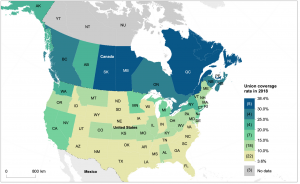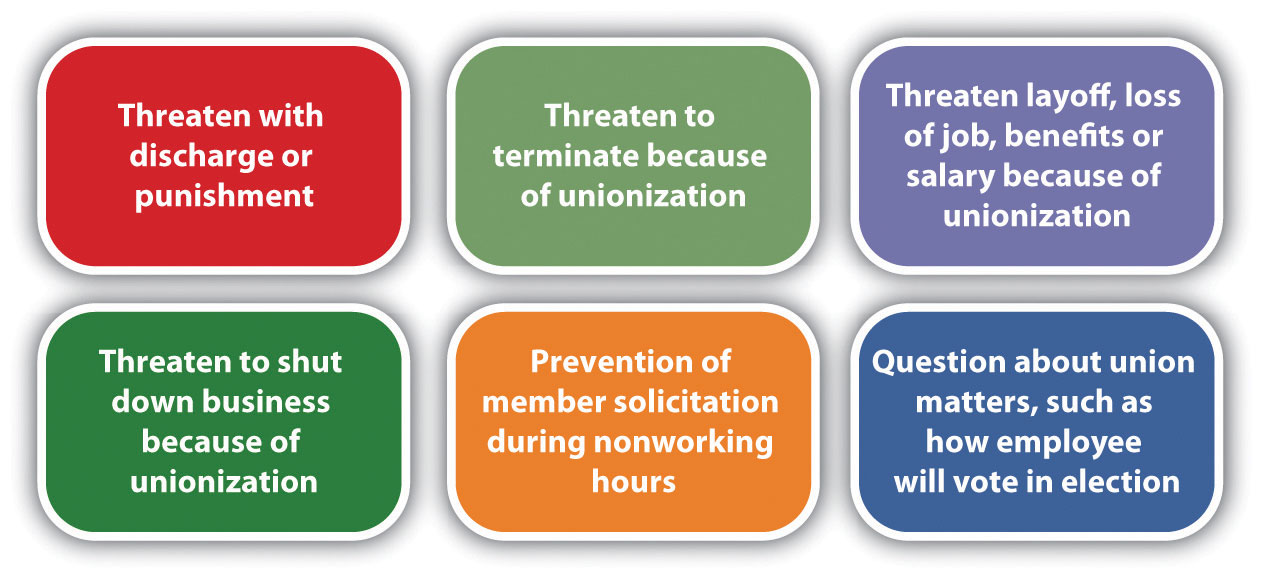Unionization process
Employees, as separate individuals, have very little power when it comes to their relationship with companies’ management. When organized as a group, however, employees gain some power and can start leveraging that power to negotiate with their employer. In this section we discuss the process that a group of employees must undertake to become an official union.
Legislation and unionization

The path to unionization and the process of maintaining a union is heavily regulated. These regulations can greatly vary from one legislation to another. In Canada, the system of collective bargaining is embodied in federal and provincial labour relations acts and labour codes. Canadian workers have the right to join trade unions, which may be certified to collectively bargain conditions of employment with their employers on their behalf. The Federal Public Service Labour Relations Act (PSLRA) is the law that regulates the collective bargaining and grievance adjudication systems in the federal public service. Provincial legislation, such as the Labour Relations Code in British Columbia, the Labour Act of Prince Edward Island, and the Quebec Labour Code, regulate various aspects of labour relations for most workplaces. In North America, the legislation with the most pro-union legislation is found in the province of Quebec. Coincidentally, it is also the jurisdiction with the highest unionization rates (40%; check out the map to see how much variation exists in North America).
Process of forming a union
The creation of a union follows has to follow a fairly strict process. First, an established union may contact employees and discuss the possibility of a union, or employees may contact a union on their own. The union will then help employees gather signatures to show that the employees want to be part of a union. To hold an election, the union must show signatures from over 35 percent of the employees of the organization.
Figure 1. The Unionization Process
| Union and employees make contact |
As a result of employee dissatisfaction, union and employees make contact and discuss possibility of joining forces. |
|---|---|
| Initial Organization Meeting |
Initial meeting with union is scheduled to gather employee support. |
| Formation of organizing committee
Application to Labour Relations Board |
Local union leadership is identified. Its objectives is to organize a campaign to obtain the signature of a majority of workers willing to join the union. |
| Certificate is issues by the Board |
Once a majority of these signatures are gathered, the workers can apply for official recognition to the Labour Relation Board. After checking the process and the signatures, the Board certifies the union. |
| Election of bargaining committee and contract negotiation |
After having been certified, the first step for the newly formed union is to elect a bargaining team that will be tasked with negotiating a contract with the employer. |
Unions approach prospective members with promises like higher pay, better health insurance, and more vacation time. Not surprisingly, then, management resist unions because they generally add to the cost of doing business. A a result, the union organizing process can be a very delicate process because most employers feel the constraints of having a union organization are too great. Collective bargaining can put management at odds with its employees.
There exists legal protection for employees considering unionization and it is advisable for HR and management to be educated on what can legally and illegally be said during this process. It is illegal to threaten or intimidate employees if they are discussing a union. Employers cannot threaten job, pay, or benefits loss as a result of forming a union. Figure 1 “Things That Shouldn’t Be Said to Employees during a Unionization Process” includes information on what should legally be avoided if employees are considering unionization.
Despite all of the above, some organizations will go to great length to prevent unionization of their workforce. In Quebec, there has been some illustrious examples of how motivated some organizations are to keep unions out. Most notably, the Wal-Mart in Jonquière became the first store in North America to be unionized in 2004. A few months later, Wal-Mart closed its store and put approximately 190 employees out of work claiming that the store was not profitable. The laid-off employees took Walmart to court and the case made it to the Supreme Court of Canada. The court found that Wal-Mart did not adequately prove the four-year-old store was in financial difficulty and violated a provision of the Quebec labour code by changing the workers’ conditions of employment without consent while the terms of the collective agreement were being negotiated. You can read about this landmark case here.


